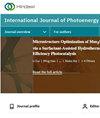PSO-ANFIS-Based Energy Management in Hybrid AC/DC Microgrid along with Plugin Electric Vehicle
IF 2.1
4区 工程技术
Q3 CHEMISTRY, PHYSICAL
引用次数: 0
Abstract
This study proposes a hybrid AC/DC microgrid with plugin EVs, leveraging PSO-tuned ANFIS for voltage and power control. With the existing control, which faced challenges such as instability and complexity, the proposed approach is aimed at simplifying control through PSO, efficient power sharing, and reduced sample requirements. This innovative method contributes to improved energy management in hybrid microgrids, bridging existing research gaps. This approach streamlines neural transmission in microgrid control, addressing challenges in distributed generation power, load demand, energy storage system SOC, and AC grid power integration. Notably, the proposed PSO-ANFIS simplifies electric vehicle power references using distinct inputs for each mode, trained through PSO. This methodology is tailored for microgrids with varying power profiles, presenting a promising solution for efficient energy management. The proposed EMS was experimentally verified using MATLAB simulations of a small-scale hybrid AC/DC microgrid for every operating mode. The financial dynamics of a microgrid’s power exchange with the main grid are examined through three distinct methodologies: fuzzy logic, ANFIS (adaptive neurofuzzy inference system), and PSO-ANFIS (ANFIS optimized using particle swarm optimization). In case 1, the PSO-ANFIS approach demonstrates its superiority by achieving the lowest grid purchase power cost of 1995.24 Rs/day compared to fuzzy (2243.63 Rs/day) and ANFIS (2150.45 Rs/day), while also yielding the highest revenue from power selling to the microgrid: PSO-ANFIS (668.84 Rs/day) surpassing fuzzy (536.12 Rs/day) and ANFIS (575.35 Rs/day). Similarly, in case 2, PSO-ANFIS proves its efficiency with the lowest net price of 8619.192 Rs/day, showcasing its effectiveness in optimizing financial dynamics. Furthermore, in case 3, the revenue aligns precisely with net prices, indicating the PSO-ANFIS method’s financial advantage, generating the highest revenue of 6544.0224 Rs/day compared to fuzzy (6025.36 Rs/day) and ANFIS (6153.214 Rs/day). These findings underscore the potential utility of the PSO-ANFIS approach in optimizing microgrid operations and enhancing cost-effectiveness across various scenarios.基于pso - anfiss的混合交直流微电网及插电式电动车能量管理
本研究提出了一个带有插件电动汽车的混合交流/直流微电网,利用pso调谐的ANFIS进行电压和功率控制。针对现有控制存在的不稳定性和复杂性等问题,本文提出的方法旨在通过粒子群算法简化控制,实现有效的功率共享和降低样本要求。这种创新方法有助于改善混合微电网的能源管理,弥合现有的研究差距。该方法简化了微电网控制中的神经传递,解决了分布式发电、负荷需求、储能系统SOC和交流电网集成等方面的挑战。值得注意的是,所提出的PSO- anfis通过PSO训练,为每种模式使用不同的输入,从而简化了电动汽车的功率参考。这种方法是为具有不同功率分布的微电网量身定制的,为有效的能源管理提供了一个有前途的解决方案。通过MATLAB仿真,对各种运行模式下的小型交直流混合微电网进行了实验验证。通过三种不同的方法来研究微电网与主电网电力交换的财务动态:模糊逻辑、自适应神经模糊推理系统(ANFIS)和PSO-ANFIS(使用粒子群优化的ANFIS)。在案例1中,与模糊(2243.63卢比/天)和ANFIS(2150.45卢比/天)相比,PSO-ANFIS方法实现了最低的电网购买电力成本,为1995.24卢比/天,同时也从向微电网出售电力中获得了最高的收入:PSO-ANFIS(668.84卢比/天)超过模糊(536.12卢比/天)和ANFIS(575.35卢比/天)。同样,在案例2中,PSO-ANFIS以最低的净价8619.192 Rs/天证明了其有效性,显示了其在优化财务动态方面的有效性。此外,在情况3中,收入与净价格精确一致,表明PSO-ANFIS方法的财务优势,与模糊(6025.36卢比/天)和ANFIS(6153.214卢比/天)相比,产生最高的收入6544.0224卢比/天。这些发现强调了PSO-ANFIS方法在优化微电网运行和提高各种情况下的成本效益方面的潜在效用。
本文章由计算机程序翻译,如有差异,请以英文原文为准。
求助全文
约1分钟内获得全文
求助全文
来源期刊
CiteScore
6.00
自引率
3.10%
发文量
128
审稿时长
3.6 months
期刊介绍:
International Journal of Photoenergy is a peer-reviewed, open access journal that publishes original research articles as well as review articles in all areas of photoenergy. The journal consolidates research activities in photochemistry and solar energy utilization into a single and unique forum for discussing and sharing knowledge.
The journal covers the following topics and applications:
- Photocatalysis
- Photostability and Toxicity of Drugs and UV-Photoprotection
- Solar Energy
- Artificial Light Harvesting Systems
- Photomedicine
- Photo Nanosystems
- Nano Tools for Solar Energy and Photochemistry
- Solar Chemistry
- Photochromism
- Organic Light-Emitting Diodes
- PV Systems
- Nano Structured Solar Cells

 求助内容:
求助内容: 应助结果提醒方式:
应助结果提醒方式:


